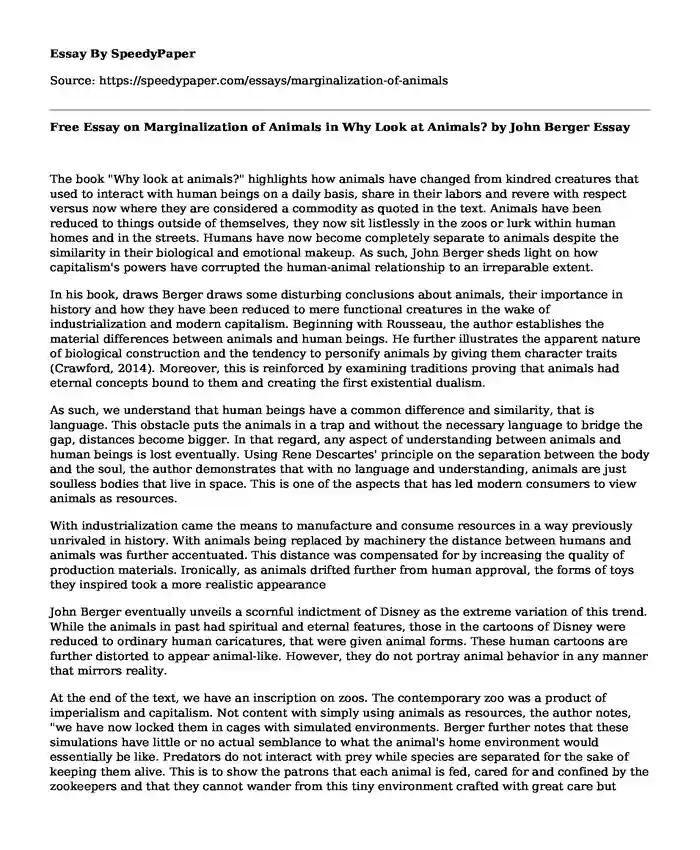The book "Why look at animals?" highlights how animals have changed from kindred creatures that used to interact with human beings on a daily basis, share in their labors and revere with respect versus now where they are considered a commodity as quoted in the text. Animals have been reduced to things outside of themselves, they now sit listlessly in the zoos or lurk within human homes and in the streets. Humans have now become completely separate to animals despite the similarity in their biological and emotional makeup. As such, John Berger sheds light on how capitalism's powers have corrupted the human-animal relationship to an irreparable extent.
In his book, draws Berger draws some disturbing conclusions about animals, their importance in history and how they have been reduced to mere functional creatures in the wake of industrialization and modern capitalism. Beginning with Rousseau, the author establishes the material differences between animals and human beings. He further illustrates the apparent nature of biological construction and the tendency to personify animals by giving them character traits (Crawford, 2014). Moreover, this is reinforced by examining traditions proving that animals had eternal concepts bound to them and creating the first existential dualism.
As such, we understand that human beings have a common difference and similarity, that is language. This obstacle puts the animals in a trap and without the necessary language to bridge the gap, distances become bigger. In that regard, any aspect of understanding between animals and human beings is lost eventually. Using Rene Descartes' principle on the separation between the body and the soul, the author demonstrates that with no language and understanding, animals are just soulless bodies that live in space. This is one of the aspects that has led modern consumers to view animals as resources.
With industrialization came the means to manufacture and consume resources in a way previously unrivaled in history. With animals being replaced by machinery the distance between humans and animals was further accentuated. This distance was compensated for by increasing the quality of production materials. Ironically, as animals drifted further from human approval, the forms of toys they inspired took a more realistic appearance
John Berger eventually unveils a scornful indictment of Disney as the extreme variation of this trend. While the animals in past had spiritual and eternal features, those in the cartoons of Disney were reduced to ordinary human caricatures, that were given animal forms. These human cartoons are further distorted to appear animal-like. However, they do not portray animal behavior in any manner that mirrors reality.
At the end of the text, we have an inscription on zoos. The contemporary zoo was a product of imperialism and capitalism. Not content with simply using animals as resources, the author notes, "we have now locked them in cages with simulated environments. Berger further notes that these simulations have little or no actual semblance to what the animal's home environment would essentially be like. Predators do not interact with prey while species are separated for the sake of keeping them alive. This is to show the patrons that each animal is fed, cared for and confined by the zookeepers and that they cannot wander from this tiny environment crafted with great care but simulated nevertheless. Overall, John Berger states that the zoo is the most absolute sin that human beings have committed to animals via the concepts of capitalism and industrialism.
References
Crawford, M. (2014, January 31). John Berger-" Why look at animals?". Retrieved from http://blog.ocad.ca/wordpress/gart1b51-fw201303-01/2014/01/john-berger-why-look-at-animals/?doing_wp_cron=1544810423.4883759021759033203125
Cite this page
Free Essay on Marginalization of Animals in Why Look at Animals? by John Berger. (2022, Nov 04). Retrieved from https://speedypaper.com/essays/marginalization-of-animals
Request Removal
If you are the original author of this essay and no longer wish to have it published on the SpeedyPaper website, please click below to request its removal:
- The History of the Texas Gun Control Policy in Our Essay Sample
- Free Essay: Relativism and Religiously Based Ethical Theories
- Essay Sample on Concept of Dark Tourism
- Cowan, A. (2018). Image, Politics, and Place: Tourism and the American City.
- Essay Example: How Will You Reach One of Your Ultimate Goals?
- Paper Example. Legal Experts
- Essay Example - "Stroop" Test
Popular categories





